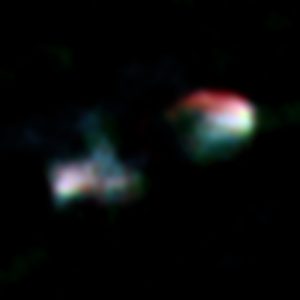
ページ読込中...

ページ読込中...

[English]
| 市川 幸平 [准教授] |  |
|
| homepage | https://motigomeman.wordpress.com/ | |
| 専門分野 | 超巨大ブラックホール | |
| キーワード | 超巨大ブラックホール 多波長天文学 観測天文学 |
|
| 研究テーマ・研究活動 | ||
| http://www.kusastro.kyoto-u.ac.jp/~ichikawa/CVfull_Japanese.pdf を参照 |
||
ガリレオ・ガリレイが望遠鏡を作成して宇宙を観測してから400年。観測装置の発展と人々の叡智の積み重ねによって様々な天体が発見され、我々が持っている宇宙観を劇的に変化させました。その中で、天文学者を含めて多くの人々を魅了し続けている天体の一つがブラックホールです。この未知の天体ですが、実は宇宙にはたくさん存在します。例えば、我々が住んでいる天の川銀河や、宇宙に数多く存在する銀河の中心を見てやると、ほぼ必ず超巨大ブラックホール (supermassive black holes; SMBHs) がいるらしいことがわかってきています。その一方で、このようなSMBHがどうやって誕生したのか? あるいはどうやってここまで大きく太ったのか?については、まだまだあんまり知ることが出来ていません。
このようなSMBH、普段は静かで観測も難しいのですが、一旦周りにガスが集まってくると、SMBHの重力ポテンシャルにガスが落ち込み、ガスの位置エネルギーが熱エネルギーに変換され、そこから光が出てきて、見事非常に明るい天体に変化します。このような天体は活動銀河核と呼ばれます。この活動銀河核を利用して中心にいるSMBHのあらゆる情報 (SMBHの質量や太る速さ) を引き出すことで、SMBHの成長の詳細を調べ、宇宙全体のSMBHの活動を掌握するのが私の研究の目標です。もっと詳しい話を知りたい方は、私のウェブサイトをご覧ください。
 VLA望遠鏡とアルマ望遠鏡の観測から得られたArp 187の電波画像 (VLA 4.86 GHzに青、VLA 8.44GHzに緑、アルマ望遠鏡 133 GHzに赤を割り当てた擬似カラー画像)。2つの電波構造が見えるが、中心核 (画像中央部)は暗く、活動銀河核が「死につつある」ことがわかる。(クレジット:ALMA (ESO/NAOJ/NRAO), Ichikawa et al.)
VLA望遠鏡とアルマ望遠鏡の観測から得られたArp 187の電波画像 (VLA 4.86 GHzに青、VLA 8.44GHzに緑、アルマ望遠鏡 133 GHzに赤を割り当てた擬似カラー画像)。2つの電波構造が見えるが、中心核 (画像中央部)は暗く、活動銀河核が「死につつある」ことがわかる。(クレジット:ALMA (ESO/NAOJ/NRAO), Ichikawa et al.)
| Kohei Ichikawa [Associate professor] |  |
|
| homepage | https://motigomeman.wordpress.com/ | |
| research field | Multiwavelength Astronomy | |
| keywords | Supermassive Black Hole Multiwavelength Astronomy Observational Astronomy |
|
| career | ||
| Please see the link below http://www.kusastro.kyoto-u.ac.jp/~ichikawa/CVfull.pdf |
||
In our universe, there are a tremendous number of galaxies. Thanks to the significant observational efforts of the past 30 years, astronomers now believe that there is at least one supermassive black hole (SMBH) with a mass ranging from 10^6 to 10^10 times that of the Sun. Remarkably, these SMBHs are ubiquitously situated at the center of each galaxy, including our very own Milky Way. However, the exact process of how SMBHs form and accumulate such enormous masses remains a mystery.
Active galactic nuclei (AGN) serve as the primary focus of these studies, as they accrete surrounding gas and convert gravitational potential energy into copious amounts of heat and thermal radiation. Despite AGN emitting intense radiation across various wavelengths, my research centers on two key spectral bands crucial for understanding SMBH growth. One is X-ray radiation, which emanates directly from the nucleus and provides insight into the current power of AGN. The other critical band is infrared (IR) radiation, which arises from the surrounding dust heated by the central engine. Infrared observations allow us to gauge the quantity of dust, or future ‘fuel’ for AGN, located around the central engine.
 The radio band composite image of Arp 187 obtained by VLA and ALMA telescopes (blue: VLA 4.86 GHz, green: VLA 8.44 GHz, red: ALMA 133 GHz). The image shows clear bimodal jet lobes, but the central nucleus (center of the image) is dark/non-detection, indicating that central AGN is “dying”. © ALMA (ESO/NAOJ/NRAO), Ichikawa et al.
The radio band composite image of Arp 187 obtained by VLA and ALMA telescopes (blue: VLA 4.86 GHz, green: VLA 8.44 GHz, red: ALMA 133 GHz). The image shows clear bimodal jet lobes, but the central nucleus (center of the image) is dark/non-detection, indicating that central AGN is “dying”. © ALMA (ESO/NAOJ/NRAO), Ichikawa et al.